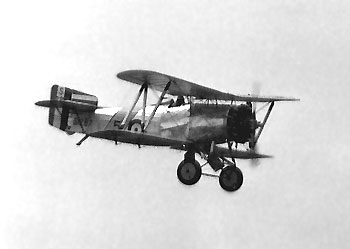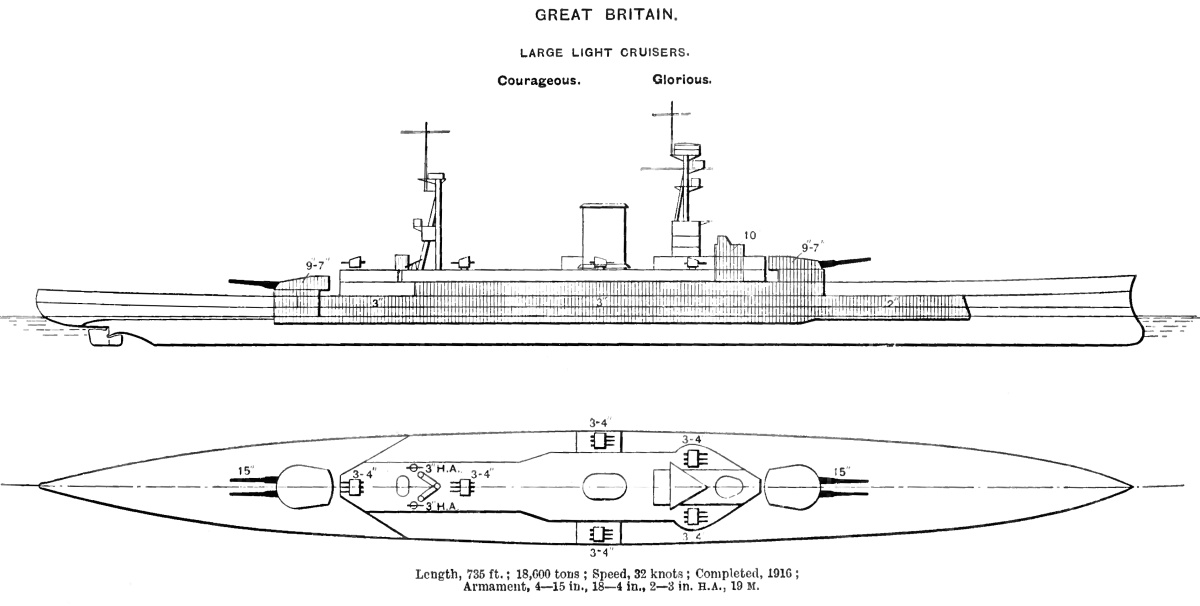|
HMS Courageous (50)
HMS ''Courageous'' was the lead ship of her class of three battlecruisers built for the Royal Navy during the First World War. Designed to support the Baltic Project championed by First Sea Lord John Fisher, the ship was very lightly armoured and armed with only a few heavy guns. ''Courageous'' was completed in late 1916 and spent the war patrolling the North Sea. She participated in the Second Battle of Heligoland Bight in November 1917 and was present when the German High Seas Fleet surrendered a year later. ''Courageous'' was decommissioned after the war, then rebuilt as an aircraft carrier during the mid-1920s. She could carry 48 aircraft compared to the 36 carried by her half-sister on approximately the same displacement. After recommissioning she spent most of her career operating off Great Britain and Ireland. She briefly became a training ship, but reverted to her normal role a few months before the start of the Second World War in September 1939. ''Courageous'' was t ... [...More Info...] [...Related Items...] OR: [Wikipedia] [Google] [Baidu] |
Armstrong Whitworth
Sir W G Armstrong Whitworth & Co Ltd was a major British manufacturing company of the early years of the 20th century. With headquarters in Elswick, Newcastle upon Tyne, Armstrong Whitworth built armaments, ships, locomotives, automobiles and aircraft. The company was founded by William Armstrong in 1847, becoming Armstrong Mitchell and then Armstrong Whitworth through mergers. In 1927, it merged with Vickers Limited to form Vickers-Armstrongs, with its automobile and aircraft interests purchased by J D Siddeley. History In 1847, the engineer William George Armstrong founded the Elswick works at Newcastle, to produce hydraulic machinery, cranes and bridges, soon to be followed by artillery, notably the Armstrong breech-loading gun, with which the British Army was re-equipped after the Crimean War. In 1882, it merged with the shipbuilding firm of Charles Mitchell to form Armstrong Mitchell & Company and at the time its works extended for over a mile (about 2 km) along ... [...More Info...] [...Related Items...] OR: [Wikipedia] [Google] [Baidu] |
Torpedo Bulkhead
A torpedo bulkhead is a type of naval armour common on the more heavily armored warships, especially battleships and battlecruisers of the early 20th century. It is designed to keep the ship afloat even if the hull is struck underneath the belt armor by a shell or by a torpedo. History After the lessons learned during World War I, many capital ships were refitted with double, triple, or even quadruple torpedo bulkheads, as well as anti-torpedo bulges to the exterior of the hull.Gillmer and Johnson, p.185 For example, the last US battleship designs during World War II had up to four torpedo bulkheads and a triple-bottom. The innermost bulkhead is commonly referred to as the ''holding bulkhead'', and often this bulkhead would be manufactured from high tensile steel that could deform and absorb the pressure pulse from a torpedo hit without breaking. If the final bulkhead was at least 37 mm thick, it may also be referred to as an ''armored bulkhead'', as it would be capable of st ... [...More Info...] [...Related Items...] OR: [Wikipedia] [Google] [Baidu] |
John Fisher, 1st Baron Fisher
John Arbuthnot Fisher, 1st Baron Fisher, (25 January 1841 – 10 July 1920), commonly known as Jacky or Jackie Fisher, was a British Admiral of the Fleet. With more than sixty years in the Royal Navy, his efforts to reform the service helped to usher in an era of modernisation which saw the supersession of wooden sailing ships armed with muzzle-loading cannon by steel-hulled battlecruisers, submarines and the first aircraft carriers. Fisher has a reputation as an innovator, strategist and developer of the navy rather than as a seagoing admiral involved in major battles, although in his career he experienced all these things. When appointed First Sea Lord in 1904 he removed 150 ships then on active service which were no longer useful and set about constructing modern replacements, developing a modern fleet prepared to meet Germany during the First World War. Fisher saw the need to improve the range, accuracy and rate-of-fire of naval gunnery, and became an early proponent of ... [...More Info...] [...Related Items...] OR: [Wikipedia] [Google] [Baidu] |
First Sea Lord
The First Sea Lord and Chief of the Naval Staff (1SL/CNS) is the military head of the Royal Navy and Naval Service of the United Kingdom. The First Sea Lord is usually the highest ranking and most senior admiral to serve in the British Armed Forces unless either the Chief or Vice-Chief of the Defence Staff are naval officers. Admiral Ben Key was appointed First Sea Lord in November 2021. Originally titled the "Senior Naval Lord to the Board of Admiralty" when the post was created in 1689, the office was re-styled "First Naval Lord" in 1771. The concept of a professional "First Naval Lord" was introduced in 1805, and the title of the office was changed to "First Sea Lord" on the appointment of Sir John Fisher in 1904. Since 1923, the First Sea Lord has been a member of the Chiefs of Staff Committee; he now sits on the Defence Council and the Admiralty Board. [...More Info...] [...Related Items...] OR: [Wikipedia] [Google] [Baidu] |
Baltic Project
The Baltic Project was a plan promoted by the Admiral Lord Fisher to procure a speedy victory during the First World War over Germany. It involved landing a substantial force, either British or Russian soldiers, on the flat beaches of Pomerania on the North German coast, less than from Berlin. Submarines and extensive mining would keep the invasion force safe from the Imperial German Navy. More than 600 vessels would be required, including landing craft, minesweepers, destroyers, light cruisers, monitors and some heavy shallow draft support ships. The latter were built in the form of the three ''Courageous''-class battlecruisers, , and .https://archive.org/stream/recordsbyadmira00fishgoog/recordsbyadmira00fishgoog_djvu.txt Records by Admiral of the Fleet Lord Fisher The plan was never implemented. See also * Operation Catherine Operation Catherine was a proposed Baltic Sea offensive by the United Kingdom's Royal Navy to be undertaken in early 1940. It aimed at interdicting Ge ... [...More Info...] [...Related Items...] OR: [Wikipedia] [Google] [Baidu] |
First World War
World War I (28 July 1914 11 November 1918), often abbreviated as WWI, was one of the deadliest global conflicts in history. Belligerents included much of Europe, the Russian Empire, the United States, and the Ottoman Empire, with fighting occurring throughout Europe, the Middle East, Africa, the Pacific, and parts of Asia. An estimated 9 million soldiers were killed in combat, plus another 23 million wounded, while 5 million civilians died as a result of military action, hunger, and disease. Millions more died in genocides within the Ottoman Empire and in the 1918 influenza pandemic, which was exacerbated by the movement of combatants during the war. Prior to 1914, the European great powers were divided between the Triple Entente (comprising France, Russia, and Britain) and the Triple Alliance (containing Germany, Austria-Hungary, and Italy). Tensions in the Balkans came to a head on 28 June 1914, following the assassination of Archduke Franz Ferdi ... [...More Info...] [...Related Items...] OR: [Wikipedia] [Google] [Baidu] |
Royal Navy
The Royal Navy (RN) is the United Kingdom's naval warfare force. Although warships were used by English and Scottish kings from the early medieval period, the first major maritime engagements were fought in the Hundred Years' War against France. The modern Royal Navy traces its origins to the early 16th century; the oldest of the UK's armed services, it is consequently known as the Senior Service. From the middle decades of the 17th century, and through the 18th century, the Royal Navy vied with the Dutch Navy and later with the French Navy for maritime supremacy. From the mid 18th century, it was the world's most powerful navy until the Second World War. The Royal Navy played a key part in establishing and defending the British Empire, and four Imperial fortress colonies and a string of imperial bases and coaling stations secured the Royal Navy's ability to assert naval superiority globally. Owing to this historical prominence, it is common, even among non-Britons, ... [...More Info...] [...Related Items...] OR: [Wikipedia] [Google] [Baidu] |
Battlecruiser
The battlecruiser (also written as battle cruiser or battle-cruiser) was a type of capital ship of the first half of the 20th century. These were similar in displacement, armament and cost to battleships, but differed in form and balance of attributes. Battlecruisers typically had thinner armour (to a varying degree) and a somewhat lighter main gun battery than contemporary battleships, installed on a longer hull with much higher engine power in order to attain greater speeds. The first battlecruisers were designed in the United Kingdom, as a development of the armoured cruiser, at the same time as the dreadnought succeeded the pre-dreadnought battleship. The goal of the design was to outrun any ship with similar armament, and chase down any ship with lesser armament; they were intended to hunt down slower, older armoured cruisers and destroy them with heavy gunfire while avoiding combat with the more powerful but slower battleships. However, as more and more battlecruisers were b ... [...More Info...] [...Related Items...] OR: [Wikipedia] [Google] [Baidu] |
Courageous-class Battlecruiser
The ''Courageous'' class consisted of three battlecruisers known as "large light cruisers" built for the Royal Navy during the First World War. The class was nominally designed to support the Baltic Project, a plan by Admiral of the Fleet Lord Fisher that was intended to land troops on the German Baltic Coast. Ships of this class were fast but very lightly armoured, with only a few heavy guns. They were given a shallow draught, in part to allow them to operate in the shallow waters of the Baltic but also reflecting experience gained earlier in the war. To maximize their speed, the ''Courageous''-class battlecruisers were the first capital ships of the Royal Navy to use geared steam turbines and small-tube boilers. The first two ships, and , were commissioned in 1917 and spent the war patrolling the North Sea. They participated in the Second Battle of Heligoland Bight in November 1917 and were present when the High Seas Fleet surrendered a year later. Their half-sister was ... [...More Info...] [...Related Items...] OR: [Wikipedia] [Google] [Baidu] |
Lead Ship
The lead ship, name ship, or class leader is the first of a series or class of ships all constructed according to the same general design. The term is applicable to naval ships and large civilian vessels. Large ships are very complex and may take as many as five to ten years to build. Improvements based on experience with building and operating the lead ship are likely to be incorporated into the design or construction of later ships in the class, so it is rare to have vessels that are identical. The second and later ships are often started before the first one is completed, launched and tested. Nevertheless, building copies is still more efficient and cost-effective than building prototypes, and the lead ship will usually be followed by copies with some improvements rather than radically different versions. The improvements will sometimes be retrofitted to the lead ship. Occasionally, the lead ship will be launched and commissioned for shakedown testing before following s ... [...More Info...] [...Related Items...] OR: [Wikipedia] [Google] [Baidu] |
Bulkhead (partition)
A bulkhead is an upright wall within the hull of a ship or within the fuselage of an airplane. Other kinds of partition elements within a ship are decks and deckheads. Etymology The word ''bulki'' meant "cargo" in Old Norse. During the 15th century sailors and builders in Europe realized that walls within a vessel would prevent cargo from shifting during passage. In shipbuilding, any vertical panel was called a head. So walls installed abeam (side-to-side) in a vessel's hull were called "bulkheads". Now, the term bulkhead applies to every vertical panel aboard a ship, except for the hull itself. History Bulkhead partitions are considered to have been a feature of Chinese junks, a type of ship. Song Dynasty author Zhu Yu (fl. 12th century) wrote in his book of 1119 that the hulls of Chinese ships had a bulkhead build. The 5th-century book ''Garden of Strange Things'' by Liu Jingshu mentioned that a ship could allow water to enter the bottom without sinking. Archaeologi ... [...More Info...] [...Related Items...] OR: [Wikipedia] [Google] [Baidu] |
QF 4
QF may stand for: * Qantas, an airline of Australia (IATA code QF) * Qatar Foundation, a private, chartered, non-profit organization in the state of Qatar * Quality factor, in physics and engineering, a measure of the "quality" of a resonant system * Quick-firing gun, a sort of artillery piece * Quiverfull, a movement of Christians who eschew all forms of birth control * A gun breech that uses metallic cartridges (see British ordnance terms#QF) * Quds Force The Quds Force ( fa, نیروی قدس, niru-ye qods, Jerusalem Force) is one of five branches of Iran's Islamic Revolutionary Guard Corps (IRGC) specializing in unconventional warfare and military intelligence operations. U.S. Army's Iraq War ... an expeditionary warfare unit of IRGC {{disambig fr:QF ... [...More Info...] [...Related Items...] OR: [Wikipedia] [Google] [Baidu] |

.jpg)

_-_March_17%2C_1924.jpg)

_(cropped).jpg)